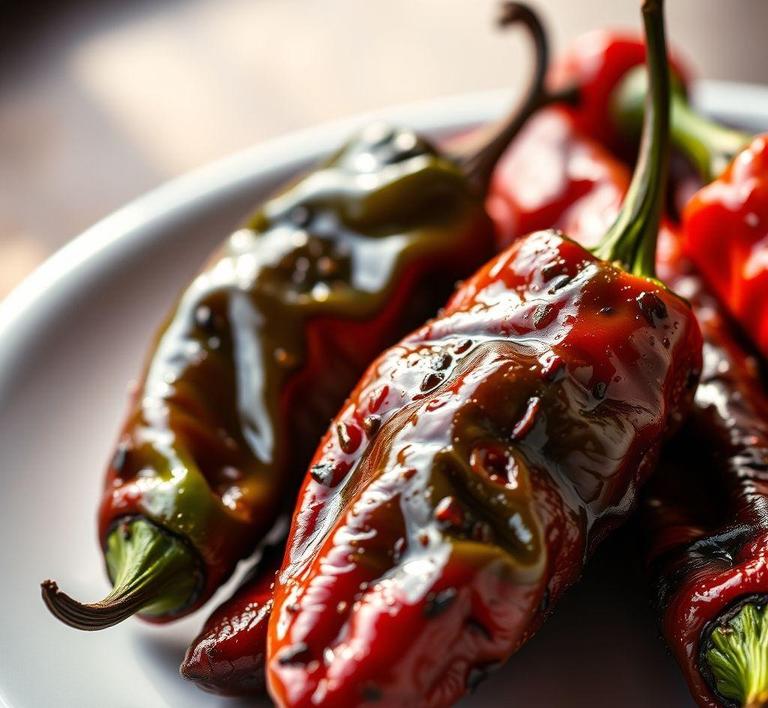So you’ve roasted a batch of chili peppers, and now you’re left wondering if you can save the extra heat for later. Well, the answer is yes! Refreezing roasted chili peppers is a fantastic way to preserve that smoky, fiery flavor for future use. Whether you’ve roasted a few too many or simply want to keep your peppers fresh for longer, this guide will walk you through the best ways to freeze, store, and defrost roasted chili peppers without losing any of their punch. Get ready to turn your pepper prep into a year-round flavor boost!
Can You Refreeze Roasted Chili Peppers?

When it comes to refreezing roasted chili peppers, the question often arises out of practical necessity: “I roasted a big batch and only used part of it-can I freeze the leftovers again”? The short answer is yes, but with important caveats regarding food safety and quality.
Food Safety Perspective:
Refreezing any previously frozen food can pose some risk if done incorrectly. When chili peppers are roasted and then initially frozen, the freezing process halts microbial growth by rendering bacteria inactive. However, once the peppers are thawed and exposed to warmer temperatures, bacteria can become active again and multiply if the peppers are left out too long or stored improperly. If you then refreeze without thoroughly reheating or cooling the peppers properly, you risk trapping those bacteria in the food, which can increase the chance of foodborne illness.
Texture and Flavor Considerations:
Roasted chili peppers have a high water content, and freezing causes ice crystals to form within their cell walls. The initial freeze already alters the texture, making peppers softer and sometimes mushy after thawing. Refreezing exacerbates this effect-each freeze-thaw cycle breaks down the structure further, leading to a loss of firmness, making the peppers more limp and watery upon final thawing.
In summary:
You can refreeze roasted chili peppers if they were thawed safely (e.g., in the refrigerator and not left out at room temperature for long). However, every freeze-thaw cycle deteriorates texture and flavor quality, so it’s best to minimize refreezing to maintain optimal taste and mouthfeel.
How To Refreeze Roasted Chili Peppers?
If you decide to refreeze roasted chili peppers, doing so properly is key to minimizing food safety risks and preserving quality as much as possible. Here’s a step-by-step guide:
-
Thaw Properly:
Always thaw frozen roasted chili peppers in the refrigerator, not at room temperature. This keeps the peppers below the ‘danger zone’ (40-140°F or 4-60°C) where bacteria thrive.
-
Inspect and Use Quickly:
Once thawed, check the peppers for any off smells, discoloration, or sliminess-signs of spoilage. Use them as soon as possible.
-
Reheat Thoroughly (Optional but Recommended):
If your recipe permits, reheat the thawed peppers to a steaming hot temperature before refreezing. This reheating kills any bacteria that may have grown during thawing, making refreezing safer.
-
Cool Quickly:
After reheating, cool the peppers quickly by spreading them in a thin layer or placing them in shallow containers and refrigerate promptly.
-
Package Properly for Refreezing:
Use airtight, freezer-safe containers or vacuum-sealed bags to limit freezer burn and preserve flavor. Remove as much air as possible to reduce oxidation and moisture loss.
-
Label and Date:
Clearly mark the refreezing date. It’s generally recommended not to refreeze more than once, and to use the peppers within 1-2 months for best quality.
-
Thaw Again Safely:
When you eventually thaw the refrozen peppers, do so in the fridge and plan to use them immediately.
By following these steps, you help ensure safety and mitigate quality degradation, although texture changes will still occur.
Quality Impact
The impact of freezing-and especially refreezing-on roasted chili peppers is mostly about texture, flavor, and moisture content.
-
Texture:
Roasted chili peppers are soft by nature, but freezing breaks down their cellular walls further. After one freeze-thaw cycle, peppers are usually softer, sometimes mushy. Refreezing intensifies this effect, leaving you with very limp, watery peppers that might be unsuitable for salads or dishes where texture matters.
-
Flavor:
The smoky, earthy flavor imparted by roasting is robust and somewhat resilient, but repeated freezing can dull some of these complex notes. Additionally, oxidation can cause subtle off-flavors if the peppers aren’t sealed well.
-
Moisture Loss and Freezer Burn:
Improper packaging can lead to freezer burn-a dry, leathery texture and unpleasant taste caused by dehydration. Refreezing without proper airtight storage increases this risk.
-
Appearance:
Refrozen roasted peppers may appear paler or have small ice crystals on their surface. While not harmful, this can affect their visual appeal.
In practical terms, while refrozen roasted chili peppers are perfectly safe when handled correctly, expect a trade-off in texture and, to a lesser degree, flavor. They are ideal for blending into sauces, soups, or stews where their integrity is less critical, but less ideal for fresh garnishes or raw applications.
Roasted chili peppers are a delicious, versatile ingredient that many enjoy preserving through freezing. While you can refreeze roasted chili peppers, doing so should be approached with caution and care to ensure food safety and the best possible quality.
To refreeze safely, always thaw in the refrigerator, inspect carefully, reheat if possible, and package tightly before returning them to the freezer. Keep in mind that each freeze-thaw cycle will impact texture-leading to softer, potentially mushy peppers-and may slightly diminish their vibrant roasted flavor.
Ultimately, if you’re planning to store roasted chili peppers long-term, aim to freeze them in manageable portions to avoid needing to refreeze. When refreezing is necessary, use them in cooked dishes where texture changes won’t be as noticeable. With proper handling, roasted chili peppers can remain a flavorful and convenient addition to your culinary repertoire, even after multiple freeze-thaw cycles.
Is It Safe To Refreeze Roasted Chili Peppers?
When it comes to food safety, the question of whether you can safely refreeze roasted chili peppers is more complex than it might first appear. The short answer is: it depends, and understanding why requires a dive into food science, storage practices, and the nature of chili peppers themselves.
Roasted chili peppers, once cooked and cooled, are often frozen to extend their shelf life. Freezing slows down microbial growth and enzymatic activity that cause spoilage. However, once thawed, the peppers’ texture and moisture content change – they become softer, often releasing water. If you then refreeze them without proper handling, you risk compromising both quality and safety.
From a safety standpoint, refreezing is only safe if the peppers were thawed properly-meaning they were kept cold (below 40°F or 4°C) and not left out at room temperature for extended periods. If you thaw the peppers in the refrigerator and they have not been at unsafe temperatures for more than two hours, refreezing can be done safely, though some quality loss is expected.
Quality concerns: Each freeze-thaw cycle damages the peppers’ cell walls, making them mushier and less vibrant in flavor and texture. Roasted chili peppers contain delicate oils and flavors that degrade with repeated freezing. So, while refreezing may not pose a serious health risk if done correctly, the sensory experience – the taste, smell, and mouthfeel – may suffer.
In summary: yes, you can refreeze roasted chili peppers safely if they’ve been thawed under proper conditions, but be prepared for some loss of quality. Always prioritize food safety first, and when in doubt, discard.
Signs That Roasted Chili Peppers Should Not Be Refrozen
Recognizing when your roasted chili peppers have gone beyond safe or ideal conditions for refreezing is crucial. Here are key warning signs that your peppers should not be refrozen:
- Off Smell: Fresh roasted chili peppers have a smoky, vibrant aroma. If you detect sour, rancid, or ‘off’ odors, this indicates spoilage or bacterial growth and they should be discarded.
- Slimy or Sticky Texture: A slippery or slimy surface is a classic indicator of microbial spoilage. If thawed peppers feel mushy beyond normal softness, or sticky in an unnatural way, it’s a warning.
- Visible Mold or Discoloration: Any sign of mold, black spots, or unusual discoloration is a clear red flag. Mold spores thrive in moist environments and refreezing won’t kill them.
- Excessive Water Loss and Freezer Burn: If the peppers have dried out in the freezer and exhibit white, leathery patches (freezer burn), refreezing after thawing will further degrade texture and flavor.
- Left at Room Temperature Too Long: If the roasted chili peppers were left out for more than two hours at room temperature, bacteria could have multiplied to unsafe levels. Even if they look and smell fine, refreezing is unsafe.
- Unusual Taste: If you’ve tasted the peppers after thawing and they have a bitter or sour note, this is another sign that spoilage may have begun.
When any of these signs are present, it’s safer to err on the side of caution and discard the peppers rather than risk foodborne illness.
Common Refreezing Mistakes
Refreezing roasted chili peppers might seem straightforward, but common mistakes can compromise food safety and quality:
- Thawing at Room Temperature: Leaving peppers out to thaw on the counter encourages rapid bacterial growth. Always thaw in the fridge or under cold running water.
- Refreezing Without Cooking: If you thaw peppers and leave them at unsafe temperatures, refreezing them doesn’t eliminate bacteria – it only pauses their growth. Reheating thoroughly before refreezing can help, but is often impractical.
- Using Inappropriate Containers: Freezing in non-airtight or unsuitable containers causes freezer burn, moisture loss, and flavor degradation. Always use airtight, freezer-safe containers or vacuum-sealed bags.
- Refreezing Multiple Times: Each freeze-thaw cycle breaks down cell structure, making peppers mushy and less flavorful. Avoid repeated refreezing by portioning peppers before freezing.
- Ignoring Storage Duration: Even frozen foods have a shelf life. Roasted chili peppers typically maintain quality for 6-8 months in the freezer. Refreezing after long storage increases risk of spoilage.
- Not Labeling: Without proper labeling of dates and contents, you might refreeze old peppers unknowingly, increasing risk of poor quality or safety hazards.
By avoiding these pitfalls, you’ll keep your roasted chili peppers safer, tastier, and longer-lasting.
Tips And Tricks
To maximize the safety and flavor of your roasted chili peppers during freezing and potential refreezing, keep these expert tips in mind:
- Cool Properly Before Freezing: Allow roasted peppers to cool completely before freezing to prevent ice crystals and moisture buildup.
- Use Single-Use Portions: Freeze in small batches or use ice cube trays to portion out peppers. This reduces the need to thaw and refreeze large amounts.
- Vacuum Seal or Use Airtight Packaging: Vacuum sealing removes air, preventing freezer burn and preserving flavor. If unavailable, use heavy-duty freezer bags and squeeze out excess air.
- Label with Date and Type: This helps track how long the peppers have been stored and avoid keeping them beyond safe periods.
- Thaw Safely: Thaw in the fridge overnight or use a microwave’s defrost setting if cooking immediately. Avoid room temperature thawing.
- Use Quickly After Thawing: Once thawed, use your roasted peppers promptly or consider incorporating them into cooked dishes, which can then be safely frozen again.
- Consider Texture in Recipes: Mushier texture from freezing is perfect for sauces, soups, stews, or salsas where peppers are blended or cooked.
- Add Acid or Oil Before Freezing: Lightly tossing roasted peppers with vinegar, lemon juice, or olive oil can help preserve flavor and texture.
Conclusion
Refreezing roasted chili peppers is a nuanced topic that balances food safety with quality considerations. While it is **technically safe to refreeze if done correctly-thawed under refrigeration, not left out, and handled with care-**each freeze-thaw cycle inevitably affects the peppers’ texture and flavor. Being vigilant about signs of spoilage, avoiding common mistakes, and employing smart freezing strategies can help you make the most of your roasted chili peppers, minimizing waste while keeping your meals delicious and safe.
By respecting these guidelines, your roasted chili peppers will stay flavorful, vibrant, and ready to spice up your culinary creations for months to come. And remember: when in doubt, it’s always safer to discard than to risk your health. Your taste buds and your safety will thank you!


